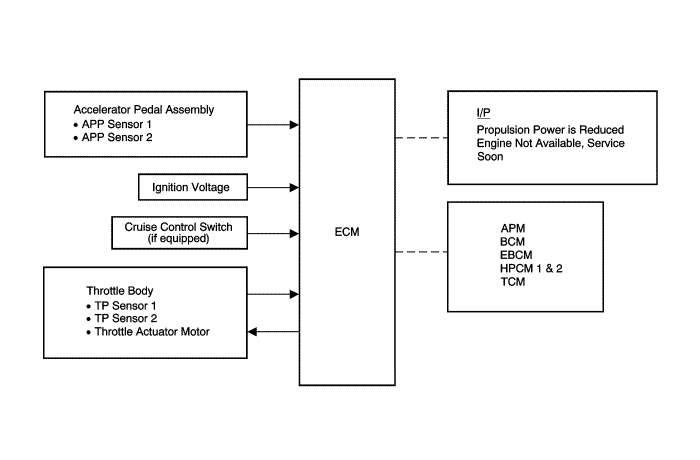Throttle Actuator Control (TAC) System Description

Circuit/System Description
The system torque coordination is provided by the hybrid powertrain control module. The engine control module (ECM) provides the accelerator pedal interface in which the driver requests a vehicle torque. These driver requests are coordinated and arbitrated within the ECM and the final driver requested torque is sent to the hybrid powertrain control module. The hybrid powertrain control module then determines how the torque output will be distributed between the two electric motors and the engine. After the torque distribution has been determined, torque reductions are imposed based upon system interrupts that are listed below:
| • | Component overheating protection |
The final arbitrated values are distributed to the system. Torque coordination of the system depends directly upon the high voltage battery pack state of charge.
This system is a distributed control system where the system torque is controlled over a system network. The system network consists of serial data communications between the controllers listed below:
| • | Engine control module (ECM) |
| • | Hybrid powertrain control module 1 and 2 (HPCM 1 and 2) |
| • | Transmission control module (TCM) |
| • | Electronic brake control module (EBCM) |
| • | Accessory Power Module (APM) |
The hybrid powertrain control module determines the engine speed which is based on the high voltage battery pack state of charge. The ECM achieves throttle positioning by providing a pulse width modulated voltage to the throttle actuator motor. The throttle blade is spring loaded in both directions, and the default position is slightly open.
Modes Of Operation
Normal Mode
During the operation of the TAC system, several modes, or functions, are considered normal. The following modes may be entered during normal operations:
| • | Minimum pedal value--At Vehicle ON, the ECM updates the learned minimum pedal value. |
| • | Minimum throttle position values--At Vehicle ON, the ECM updates the learned minimum throttle position value. In order to learn the minimum throttle position value, the throttle blade is moved to the closed position. |
| • | Ice break mode--If the throttle blade is not able to reach a predetermined minimum throttle position, the ice break mode is entered. During the ice break mode, the ECM commands the maximum pulse width several times to the throttle actuator motor in the closing direction. |
| • | Battery saver mode--After a predetermined time without engine speed, the ECM commands the battery saver mode. During the battery saver mode, the ECM disables the TAC motor control circuits, which removes the current draw used to maintain the engine speed and allows the throttle to return to the spring loaded default position. |
Reduced Power Mode
When the ECM detects a condition with the TAC system, the ECM may enter a propulsion power reduced mode. Propulsion power reduced mode may cause one or more of the following conditions:
| • | Acceleration limiting--The ECM will continue to use the accelerator pedal for propulsion control, however, the vehicle acceleration is limited. |
| • | Limited throttle mode--The ECM will continue to use the accelerator pedal for propulsion control, however, the propulsion power is reduced. |
| • | Throttle default mode--The ECM will turn OFF the throttle actuator motor, and the throttle will return to the spring loaded default position. |
| • | Forced idle mode--The ECM will ignore the accelerator pedal input. |
| • | Engine shutdown mode--The ECM will disable fuel and de-energise the throttle actuator. |
| ©© Copyright Chevrolet. All rights reserved |
